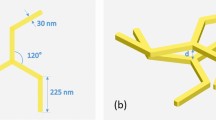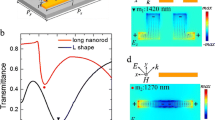Abstract
We extend the plasmon hybridization method from a single nanoparticle to a complex planar nanostructure, decomposing the complex nanostructure into fundamental nanoparticle building blocks. Using gammadion nanostructure as an example, we validated the theory by comparing the field profile in the gammadion’s arms under the influence of an incident circularly polarized wave. This allows us to address the origin of the plasmonics modes in the circular dichroism (CD) spectrum. The use of this hybridization method provides a simple and intuitive explanation on how conductive and inductive coupling may result from complex planar nanostructures, allowing us to study its optical properties. Using our approach, top down hybridization studies can be applied to other complex planar structures to gain further insight on the origin of the CD modes and enhance ultrasensitive sensing of chiral micro and macro molecules.







Similar content being viewed by others
References
Fasman GD (1996) Circular dichroism and the conformational analysis of biomolecules. Plenum US, New York
Greenfield NJ (2007) Using circular dichroism spectra to estimate protein secondary structure. Nat Protoc 1:2876
Correa DHA, Ramos CHI (2009) The use of circular dichroism spectroscopy to study protein folding, form and function. Afr J Biochem Res 3(5):164
Hendry E, Carpy T, Johnston J, Popland M, Milhaylovskiy RV, Lapthorn AJ, Kelly SM, Barron LD, Gadegaard N, Kadodwala M (2010) Ultrasensitive detection and characterisation of biomolecules using superchiral fields. Nat Nanotechnol 5:783
Zhao R, Zhang L, Zhou J, Koschny T, Soukoulis CM (2011) Conjugated gammadion chiral metamaterial with uniaxial optical activity and negative refractive index. Phys Rev B 83:035105
Rogacheva AV, Fedotov VA, Schwanecke AS, Zheludev NI (2006) Giant gyrotropy due to electromagnetic coupling. Phys Rev Lett 97:177401
Decker M, Klein MW, Wegener M, Linden S (2007) Circular dichroism of planar chiral magnetic metamaterials. Opt Lett 32(7):856
Prodan E, Radloff C, Halas NJ, Nordlander P (2003) A hybridization model for the plasmon response of complex nanostructures. Science 302:419
Wang H, Brandl DW, Le F, Nordlander P, Halas NJ (2006) Nanorice: a hybrid plasmonic nanostructure. Nano Lett 6:827
Hao F, Nehl CL, Hafner JH, Nordlander P (2007) Plasmon resonances of a gold nanostar. Nano Lett 7(3):729
Prodan E, Nordlander P (2004) Plasmon hybridization in spherical nanoparticles. J Chem Phys 120(11):5444
Bao K, Sobhani H, Nordlander P (2010) Plasmon hybridization for real metals. Chin Sci Bull 55(24):2629
Nordlander P, Prodan E (2004) Plasmon hybridization in nanoparticles near metallic surfaces. Nano Lett 4(11):2209
Lassiter JB, Azipurua J, Hernandez LI, Brandl DW, Romero I, Lal S, Hafner JH, Nordlander P, Halas NJ (2008) Close encounters between two nanoshells. Nano Lett 8(4):1212
Liu N, Giessen H (2010) Coupling effects in optical metamaterials. Angew Chem 49:9383
Palik ED (ed) (1998) Handbook of optical constants of solids. Academic, San Diego
Rodger A, Norden B (1997) Circular dichroism and linear dichroism. Oxford University Press, Oxford
Maier SA (2007) Plasmonics: fundamentals and applications. Springer Publishers, New York
Svirko YP, Zheludev NI (1998) Polarization of light in nonlinear optics. Wiley Press, New York
Born M (1915) The natural optical activity of liquids and gases. Phys Z 16:251
Yin X, Schaferling M, Metzger B, Giessen H (2013) Interpreting chiral nanophotonic spectra: the plasmonic Born-Kuhn model. Nano Lett 13(12):6238
Acknowledgments
We acknowledge the support of this research by A*STAR Joint Council Office with Grant #12302FG012. We also acknowledge the financial support from Scientific Staff Development Award, A*STAR Institute of High Performance Computing, Singapore.
Author information
Authors and Affiliations
Corresponding author
Appendix
Appendix
Correlation of Mode m1 with Period of the Gammadion Array, a 0
The period of the gammadion array, a 0 is varied in the equation [18].
Since our structure is only fundamental, we only consider the fundamental SPP modes. For fundamental SPP modes, n = m = 1 for the mode on the gammadion. The effective localized surface plasmon is given as
We plot the graph of Eq. 6 with the wavelength positions of mode m1 in the CD spectra for different periods of the gammadion array. We simulate the gammadion array with periods of 850, 800, 750, 700 and 650 nm. Figure 8 shows the comparison between the model and simulation results.
Plot of the Eq. 6 and mode 1 from CD spectra
From Fig. 8, we observed that Eq. 6 and the wavelength positions of mode m1 in CD spectra match excellently.
Calculation of Potential/Interaction Energy, U Between a Transverse Dipole and a Longitudinal Dipole to Account for Conductive Coupling in a Gammadion Structure
Circularly polarized light involves the superposition of both E x and E y polarized waves, assuming that the wave propagates in the z direction. Hence, it requires the consideration of both longitudinal and transverse coupling.
We can represent the transverse dipole as a separation of positive and negative charge + q 1 and − q 1, respectively. Similarly, the longitudinal dipole can be considered as a separation of positive and negative charge + q 2 and − q 2, respectively. Hence, the interaction energy, U, can be represented as follows, whereby \( \frac{1}{4\pi {\varepsilon}_0} \) refers to the electrostatic constant. We have also defined x 1 to be the distance between − q 1 and − q 2, x 2 to be the distance between − q 1 and + q 2, x 3 to be the distance between + q 1 and − q 2 and x 4 to be the distance between + q 1 and + q 2.

We need to obtain values for x 1, x 2, x 3 and x 4.
Using the Pythagoras theorem,
To simplify the expression, let \( x=\frac{d}{2r} \)
Using Taylor series expansion,
where p 1 = q 1 d and p 2 = q 2 d
p 1,2 = dipole moment of 1,2
Relation Between Energy Difference and Wavelength Difference
When ∂E decreases, ∂λ decreases as well.
Rights and permissions
About this article
Cite this article
Phua, W.K., Hor, Y.L., Leong, E.S.P. et al. Study of Circular Dichroism Modes Through Decomposition of Planar Nanostructures. Plasmonics 11, 449–457 (2016). https://doi.org/10.1007/s11468-015-0065-5
Received:
Accepted:
Published:
Issue Date:
DOI: https://doi.org/10.1007/s11468-015-0065-5





